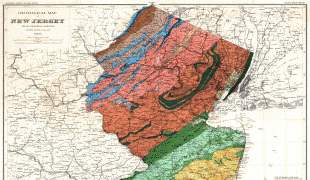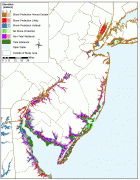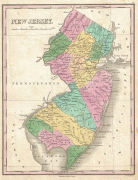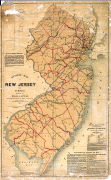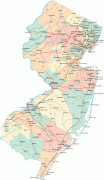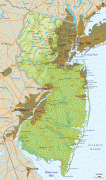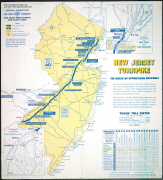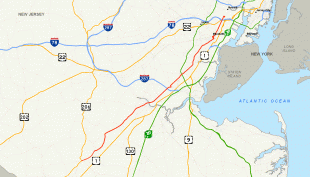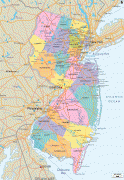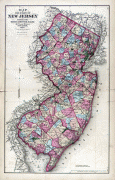New Jersey (New Jersey)
 |
 |
New Jersey was first inhabited by Native Americans for at least 2,800 years, with the Lenape being the dominant group when Europeans arrived in the early 17th century. Dutch and Swedish colonists founded the first European settlements in the state. The British later seized control of the region and established the Province of New Jersey, named after the largest of the Channel Islands. The colony's fertile lands and relative religious tolerance drew a large and diverse population. New Jersey was among the Thirteen Colonies that supported the American Revolution, hosting multiple pivotal battles and military commands in the American Revolutionary War. The state remained in, and supported, the Union during the American Civil War. Following the Civil War's end, the state emerged as a major national center of manufacturing and immigration, helping drive the Industrial Revolution and becoming the site for many industrial, technological, and commercial innovations into the mid 20th century.
Since New Jersey's December 18, 1787, founding, many notable New Jersey residents have contributed to the nation's emergence as a global economic and political superpower, making substantial contributions across academics, activism, art, business, entertainment, government and politics, military, music, religion, science, and in other fields.
New Jersey's central location in the Northeast megalopolis helped fuel its rapid growth and suburbanization in the second half of the 20th century. At the turn of the 21st century, its economy increasingly diversified, with major sectors including biotechnology, pharmaceuticals, specialized agriculture, and informational technology. New Jersey remains a major destination for immigrants and has one of the most multicultural populations in the U.S. Echoing historical trends, the state has increasingly re-urbanized, with growth in cities outpacing suburbs since 2008. New Jersey is one of the wealthiest states in the U.S. with the third highest median household income. Almost one-tenth of all households, or over 323,000 of 3.3 million, are millionaires, the highest per capita rate of millionaires of any state in the country. New Jersey's public school system consistently ranks at or among the top of all U.S. states.
Around 180 million years ago, during the Jurassic Period, New Jersey bordered North Africa. The pressure of collision between North America and Africa gave rise to the Appalachian Mountains. Around 18,000 years ago, the Ice Age resulted in glaciers that reached New Jersey. As glaciers retreated, they left behind Lake Passaic along with rivers, grasslands, swamps, and gorges.
New Jersey was originally settled by Native Americans with the Lenni-Lenape tribe being dominant at the time. Scheyichbi is the Lenape name for land that is now New Jersey. Lenape were several autonomous groups that practiced maize agriculture in order to supplement their hunting and gathering in the region surrounding the Delaware River, the lower Hudson River, and western Long Island Sound. Lenape society was divided into matrilinear clans that were based upon common female ancestors. Clans were organized into three distinct phratries identified by their animal sign: Turtle, Turkey, and Wolf. They first encountered the Dutch in the early 17th century, and their primary relationship with the Europeans was through fur trade.
Map - New Jersey (New Jersey)
Map
Country - United_States
 |
 |
| Flag of the United States | |
Indigenous peoples have inhabited the Americas for thousands of years. Beginning in 1607, British colonization led to the establishment of the Thirteen Colonies in what is now the Eastern United States. They quarreled with the British Crown over taxation and political representation, leading to the American Revolution and proceeding Revolutionary War. The United States declared independence on July 4, 1776, becoming the first nation-state founded on Enlightenment principles of unalienable natural rights, consent of the governed, and liberal democracy. The country began expanding across North America, spanning the continent by 1848. Sectional division surrounding slavery in the Southern United States led to the secession of the Confederate States of America, which fought the remaining states of the Union during the American Civil War (1861–1865). With the Union's victory and preservation, slavery was abolished nationally by the Thirteenth Amendment.
Currency / Language
| ISO | Currency | Symbol | Significant figures |
|---|---|---|---|
| USD | United States dollar | $ | 2 |
| ISO | Language |
|---|---|
| EN | English language |
| FR | French language |
| ES | Spanish language |






